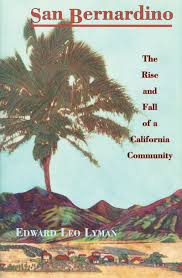Articles/Essays – Volume 30, No. 3
A Tragic Story of Loss | Edward Leo Lyman, San Bernardino: The Rise and Fall of a California Community
This award-winning book by Professor Leo Lyman of Victor Valley College is the product of many years of research and writing. He takes the reader through diaries, letters, records kept by church clerks, newspaper accounts from California and Utah in describing all that happened in the San Bernardino Valley before and after the San Bernardino colony was established by Brigham Young in the fall of 1851 and was then recalled by him in 1857.
This impressive book, with maps and photographs, and dramatic narrative, will interest all who enjoy de tailed history of the period when colonizing the Mormon territory took place.
Lyman describes the history of the region before the American Period: the native people, the Spanish Fathers who converted them to Christianity, the Spanish ranchers, the early trappers and explorers, followed by westering Americans. Into this mix was added the very different group of Latter-day Saints coming from Utah. The mix was made more complex by the inclusion of members from the South, with their slaves, and the returned Pacific Island missionaries, with their Polynesian converts. Add more: the less faithful Saints who did not care for the cold of Utah or the restrictions placed upon them there. The stage is set for the great drama that is played out.
The LDS church held a central position in the colony with apostles Charles C. Rich and Amasa M. Lyman resident emissaries of President Brigham Young. Under them the colony was founded and managed. The author sees clearly the devastating effect on the colony of Brigham Young’s initial support turned awry and eventual opposition. Divisions plagued the colony.
Chapter six is a favorite exposition of the social history of the people sacrificing and helping all to enjoy the blessings of the gospel plan. The chapter shows how the people lived, worshipped, and played together. This was not Utah, but California, where others could acquire free land and run for public office without approval of the local high council. Mormon political practice took a different position with regard to democracy. Church unity in politics was hard to establish and retain.
By the time of the “Mormon War,” the stage had been set for the removal of the “true saints” from the place that President Young had come to detest. Chapter eight, “Exodus and After,” gives the story of what happened as the settlers had to give up on payment for the remainder of the purchase and get only what they could to cross the desert and return to live in near poverty in the communities of southern Utah, Arizona, and New Mexico. It is a tragic story of loss of property and homes, of families split up, of travel most difficult. Then the travellers learn the war was over while they were still on the march, and that with a little help from Brigham Young the colony could have survived and become prosperous enough so that those who wanted to leave could do so without so much pain and sacrifice.
The extensive bibliography at tests to the fact that the text is well founded on appropriate sources. The history of Mormon San Bernardino has been written!
San Bernardino: The Rise and Fall of a California Community. By Edward Leo Lyman (Salt Lake City: Signature Books, 1996).


 Back to full Issue
Back to full Issue

